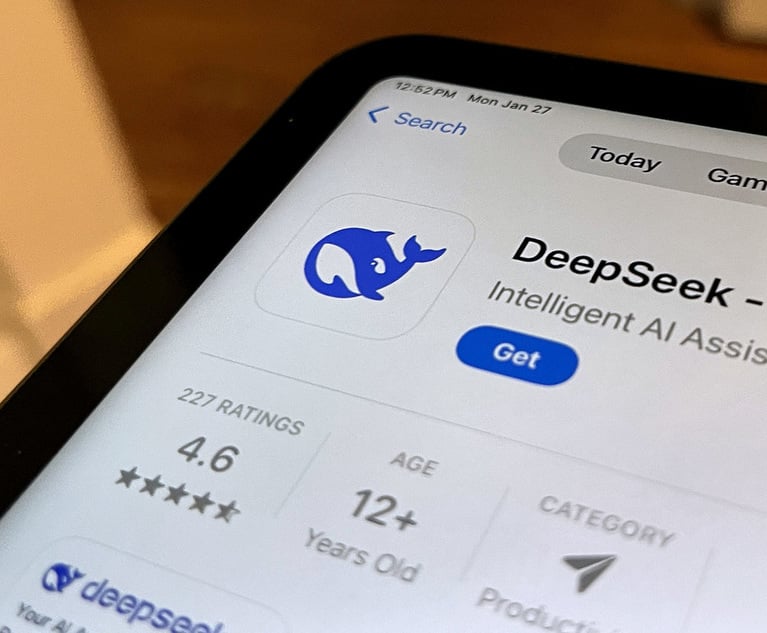Why your law firm isn't anywhere near as profitable as you think
Do conventional metrics significantly overstate law firm profitability?
October 08, 2017 at 05:14 PM
6 minute read
By conventional measures, the world's top law firms are some of the most profitable businesses on earth.
The average profit margin for the Global 100 is a lofty 39%, according to data published this month by The American Lawyer. The highest profit margin in the group, which goes to Quinn Emanuel Urquhart & Sullivan, is almost 68%. That is more than three-and-a-half times the net margin of tech giant Apple, and more than nine times that of Warren Buffett's Berkshire Hathaway, based on each company's returns in the last quarter.
How can that be possible?
It is true that law firms have little in the way of fixed costs, beyond staffing and office rent, and that fee rates remain high despite growing pressure from clients. But it's still a massive difference.
It's also completely false.
What if I were to tell you that most big law firms actually have profit margins of less than 15%? Some generate virtually no true profit at all.
The crux of this issue is the way that equity partners are compensated. Traditional law firm partnership structures are effectively unable to retain any earnings at the end of each financial year. Except for any planned investments, all remaining profit – what the Global 100 survey refer to as 'net income' – is distributed among the equity partners in full.
Compared to companies in other industries, this gives law firms an artificially high profit margin, since from an accounting perspective, equity partners receive no above-the-line salary and therefore represent no cost to the business. It also means that the most popular metrics used to assess law firm profitability – profit margin and profit per equity partner (PEP) – are susceptible to distortion by leverage.
Take two 100-lawyer firms that generate identical revenue. Firm A has 90 equity partners and 10 associates, while Firm B has 10 equity partners and 90 associates. Assuming its associate salaries and other costs are the same, Firm A will appear significantly more profitable than Firm B, as its bottom line will only be affected by the cost of 10 associates, rather than 90. (This can also cause tension between a law firm's various teams and practices, where differences in leverage can create the illusion of profit disparity.)
Even profit per lawyer, which I personally consider a much better way to assess a firm's relative profitability than PEP, is not fully immune to this problem.
The solution is relatively simple – in principle, at least: you just assign equity partners with a notional salary and deduct this cost from net income, leaving 'true' profits. Actually setting an appropriate salary for each individual firm is not quite so straightforward, however, and doing so risks introducing a degree of subjectivity to financial analysis that is designed to be as objective and accurate as possible.
Assigning a salary cost of $1m per equity partner sees Linklaters' profit margin drop from 46% to 24%
I've experimented with notional equity partner salaries before. It formed part of a formula I created back in 2012 to value law firms as businesses as part of an article in The American Lawyer. I used a market-wide equity partner salary cost set at 50% of each firm's net income, which left a cashflow that was then subject to a multiple that varied depending on the firm's size, its historic growth rates in revenue and profits, and its brand strength.
It was an imperfect and somewhat broad-stroke approach that was more designed to shed light on the issues an investor would face when analysing a law firm target, rather than to provide precise valuations. (For those interested in the results, Kirkland & Ellis narrowly edged out Latham & Watkins as the world's most valuable law firm, with a business worth just shy of $4bn. Quinn Emanuel was the clear leader by value per equity partner, with the effective stakes held by its owners worth more than $17m on average.)
I recently broached this subject again with Alan Hodgart, managing director of London consulting firm Hodgart Associates. He shares my frustrations with the way that law firm profits are reported, and has come up with a far neater method of calculating notional equity partner salary costs than my previous one-size-fits-all approach.
He suggests either adding a 25%-30% premium to each firm's highest-paid salaried fee-earner, or matching the compensation packages offered to general counsel at the firm's core clients. This equates to a notional equity partner salary of about $1m (£750,000) at an elite firm, $650,000 (£500,000) at a mid-market firm, and about $400,000 (£300,000) at firms focused on lower-margin, commoditised work.
Applying these figures to The American Lawyer's latest law firm financial survey data has dramatic results.
Assigning a salary cost of $1m per equity partner sees Latham's profit margin fall from 50% to 34%; Linklaters' drop from 46% to 24%; and Jones Day's crash from 49% to just 2%. (Impressively, Quinn Emanuel and Wachtell Lipton Rosen & Katz's profit margins both remain above 50%, even after such deductions.)
Among the mid-market firms, a notional salary of $650,000 (£500,000) per equity partner sees Baker McKenzie's profit margin halve from 34% to 17%, and DLA Piper's drop from 26% to 16%. The same figure wipes out Norton Rose Fulbright's profit entirely, with its margin plummeting from 31% to 0.003%.
It is easy to dismiss this as the kind of self-reflective navel-gazing of which firms are so often guilty. As much as partners like to obsess over and endlessly debate these issues, the truth is that a law firm's inner workings are of little interest to anyone outside the industry. Clients couldn't care less about financial metrics and partner compensation systems, so long as the service they're receiving is good, right?
Well, not entirely. Hodgart said law firms are actually "shooting themselves in the foot" by publishing artificially high profit margins that do not account for the cost of equity partners. "Clients see these results, compare them to those of their own business, which are usually much lower, and wonder why they are paying such high fees," he said.
One might also consider the potential impact on a partnership's attitude towards costs and efficiency. I go back to Norton Rose as an example. It's not a big deal if clients ask for discounts when your firm's profit margin is 31%. But at a margin of 0.003%, even the smallest discount would mean that work had effectively been carried out at a loss.
I'm very keen to hear readers' thoughts on this issue. Does the way that the industry measures law firm profitability need to be addressed? What changes, if any, would you like to see? Feel free to get in touch.
This content has been archived. It is available through our partners, LexisNexis® and Bloomberg Law.
To view this content, please continue to their sites.
Not a Lexis Subscriber?
Subscribe Now
Not a Bloomberg Law Subscriber?
Subscribe Now
NOT FOR REPRINT
© 2025 ALM Global, LLC, All Rights Reserved. Request academic re-use from www.copyright.com. All other uses, submit a request to [email protected]. For more information visit Asset & Logo Licensing.
You Might Like
View All
DeepSeek and the AI Revolution: Why One Legal Tech Expert Is Hitting Pause
4 minute read
What Happens When a Lateral Partner's Guaranteed Compensation Ends?

Lawyers React To India’s 2025 Budget, Welcome Investment And Tax Reform

Russia’s Legal Sector Is Changing as Western Sanctions Take Their Toll
5 minute readTrending Stories
- 1States Accuse Trump of Thwarting Court's Funding Restoration Order
- 2Microsoft Becomes Latest Tech Company to Face Claims of Stealing Marketing Commissions From Influencers
- 3Coral Gables Attorney Busted for Stalking Lawyer
- 4Trump's DOJ Delays Releasing Jan. 6 FBI Agents List Under Consent Order
- 5Securities Report Says That 2024 Settlements Passed a Total of $5.2B
Who Got The Work
J. Brugh Lower of Gibbons has entered an appearance for industrial equipment supplier Devco Corporation in a pending trademark infringement lawsuit. The suit, accusing the defendant of selling knock-off Graco products, was filed Dec. 18 in New Jersey District Court by Rivkin Radler on behalf of Graco Inc. and Graco Minnesota. The case, assigned to U.S. District Judge Zahid N. Quraishi, is 3:24-cv-11294, Graco Inc. et al v. Devco Corporation.
Who Got The Work
Rebecca Maller-Stein and Kent A. Yalowitz of Arnold & Porter Kaye Scholer have entered their appearances for Hanaco Venture Capital and its executives, Lior Prosor and David Frankel, in a pending securities lawsuit. The action, filed on Dec. 24 in New York Southern District Court by Zell, Aron & Co. on behalf of Goldeneye Advisors, accuses the defendants of negligently and fraudulently managing the plaintiff's $1 million investment. The case, assigned to U.S. District Judge Vernon S. Broderick, is 1:24-cv-09918, Goldeneye Advisors, LLC v. Hanaco Venture Capital, Ltd. et al.
Who Got The Work
Attorneys from A&O Shearman has stepped in as defense counsel for Toronto-Dominion Bank and other defendants in a pending securities class action. The suit, filed Dec. 11 in New York Southern District Court by Bleichmar Fonti & Auld, accuses the defendants of concealing the bank's 'pervasive' deficiencies in regards to its compliance with the Bank Secrecy Act and the quality of its anti-money laundering controls. The case, assigned to U.S. District Judge Arun Subramanian, is 1:24-cv-09445, Gonzalez v. The Toronto-Dominion Bank et al.
Who Got The Work
Crown Castle International, a Pennsylvania company providing shared communications infrastructure, has turned to Luke D. Wolf of Gordon Rees Scully Mansukhani to fend off a pending breach-of-contract lawsuit. The court action, filed Nov. 25 in Michigan Eastern District Court by Hooper Hathaway PC on behalf of The Town Residences LLC, accuses Crown Castle of failing to transfer approximately $30,000 in utility payments from T-Mobile in breach of a roof-top lease and assignment agreement. The case, assigned to U.S. District Judge Susan K. Declercq, is 2:24-cv-13131, The Town Residences LLC v. T-Mobile US, Inc. et al.
Who Got The Work
Wilfred P. Coronato and Daniel M. Schwartz of McCarter & English have stepped in as defense counsel to Electrolux Home Products Inc. in a pending product liability lawsuit. The court action, filed Nov. 26 in New York Eastern District Court by Poulos Lopiccolo PC and Nagel Rice LLP on behalf of David Stern, alleges that the defendant's refrigerators’ drawers and shelving repeatedly break and fall apart within months after purchase. The case, assigned to U.S. District Judge Joan M. Azrack, is 2:24-cv-08204, Stern v. Electrolux Home Products, Inc.
Featured Firms
Law Offices of Gary Martin Hays & Associates, P.C.
(470) 294-1674
Law Offices of Mark E. Salomone
(857) 444-6468
Smith & Hassler
(713) 739-1250









